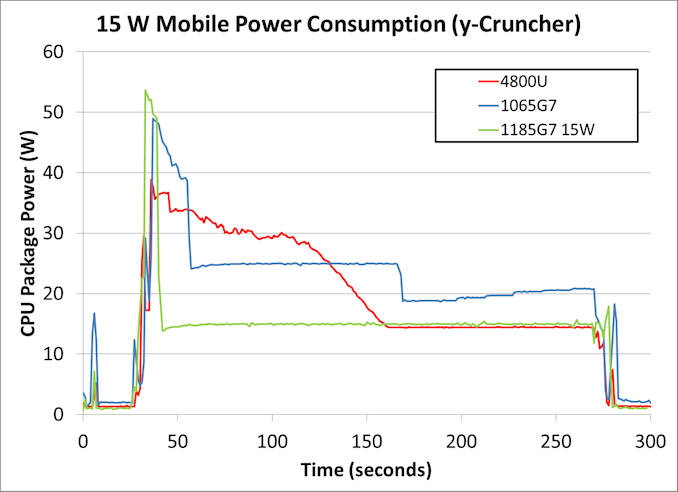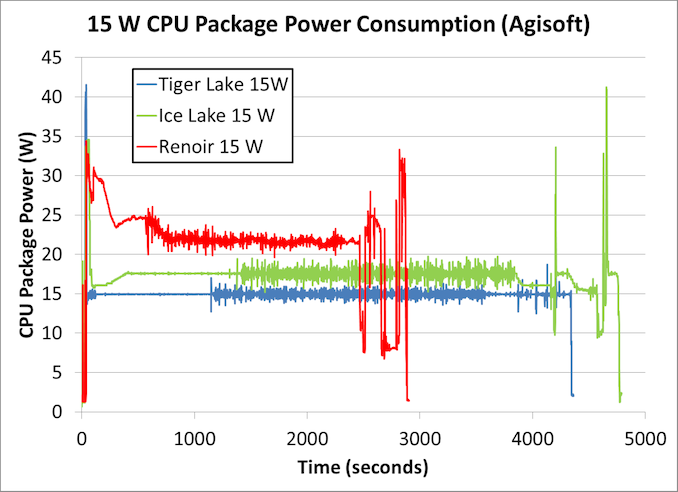Intel’s Tiger Lake 11th Gen Core i7-1185G7 Review and Deep Dive: Baskin’ for the Exotic
by Dr. Ian Cutress & Andrei Frumusanu on September 17, 2020 9:35 AM EST- Posted in
- CPUs
- Intel
- 10nm
- Tiger Lake
- Xe-LP
- Willow Cove
- SuperFin
- 11th Gen
- i7-1185G7
- Tiger King
Comparing 15 W TGL to 15 W ICL to 15 W Renoir
Despite the hullaballoo with the 28 W numbers on Tiger Lake, we suspect that most OEMs will still be positioning the hardware inside chassis built for the 15 W ultraportable market. This is where most of Intel’s OEMs have had success over the last decade, as the lower cooling requirements allow for a more user-friendly design. At 28 W, there is more of a cross-over into laptops that have discrete graphics options, and the main company that has succeeded in offering 28 W laptops without discrete graphics has been Apple - most Intel partners, if they want discrete graphics, end up looking at the 45 W processors with more cores.
So in that respect, our main battle should occur between the products built for 15 W. To that end we have been able to put the three together that will command this holiday season’s offerings: Ice Lake, Tiger Lake, and AMD’s Renoir.
- For our Ice Lake system, we have the Microsoft Surface Laptop 3. This has the top-of-the-line quad-core Core i7-1065G7, along with 16 GB of LPDDR4X-3733. Base 1.3 GHz, Turbo 3.9 GHz. Because this is an OEM design, Microsoft have determined the PL1 and PL2 values, and so they might be different from a ‘base’ design, however this is data from a real system.
- The Tiger Lake system is our Reference Design from Intel, running the quad-core Core i7-1185G7 at 15 W TDP mode. It has 16 GB of LPDDR4X-4266. Base 1.8 GHz, Turbo 4.8 GHz.
- Our AMD Renoir system is one of the most premium examples of AMD’s Ryzen Mobile in a 15W form factor, the Lenovo Yoga Slim 7 with the eight-core Ryzen 7 4800U processor. Even when set to the highest performance mode, the system still operates with a 15 W sustained power draw. It comes equipped with 16 GB of LPDDR4X-4266. Base 1.8 GHz, Turbo 4.2 GHz.
Compute Workload
For our 15 W comparisons, we can look again at the same benchmarks as the previous page. First up is y-Cruncher, an AVX2/AVX512 compute workload that tasks the CPU and the memory by calculating 2.5 billion digits of Pi, and requires ~11 GB of DRAM.
As we saw on the previous page, our Tiger Lake system in green at 15 W turbos up to ~53 watts before very quickly coming down to 15 W for the rest of the test.
The Microsoft Surface Laptop 3, by virtue of an OEM system, has different behavior - it turbos for longer, settles into a short turbo limit of 25 W, and then after about two minutes comes down to 20 W. The system then appears to opportunistically up the power draw until the end of the test, likely due to detecting extra thermal headroom.
The AMD Renoir processor does not turbo as high, peaking at only 38.9 W. Over the course of the next 100 seconds or slow, we see a small ramp down to just under 30 watts, before a more consistent decline over 30 seconds to 15 W, before staying at 15 W for the full test. The Renoir here has eight cores rather that four, but is running AVX2 rather than AVX-512 code.
The results are as follows:
- Ice Lake: 233 seconds, for 6072 joules, averaging 26.1 W
- Tiger Lake: 241 seconds for 4082 joules, averaging 17.0 W
- Renoir: 234 seconds for 5386 joules, averaging 23.0 W
All three systems perform the test in roughly the same amount of time, however the Tiger Lake system is very much ahead for efficiency. Tiger Lake effectively shaves off a third of the power from the previous generation Ice Lake system. We weren’t expecting this much of a jump from Ice Lake to Tiger Lake, but it would appear that Intel has done some work on the AVX-512 unit, and is putting that new high-performance transistor to use.
Professional ISV Workload
Moving onto the Agisoft test - as mentioned on the previous page, this is a 2D image to 3D modeling workflow where the algorithm comes in four stages, some of which prefer full multi-thread throughput, while others are more frequency and memory sensitive.
First, the Renoir finishes in almost half the time, mostly due to the fact that it has double the number of cores - there is no AVX-512 codepath in this test, and so all the processors rely on a mix of SSE, AVX, and perhaps some AVX2. That aside, the turbo behavior of Renoir is very interesting - we get almost 10 minutes of higher-than-base performance before the algorithm sets into a routine, hovering around 22 W. Because this test doesn’t attack the vector units as hard as the previous test, it may be a case that the Renoir system can manage the power distribution a bit better between the eight cores, allowing for the higher turbo.
Between the Ice Lake and the Tiger Lake, from the graph it would appear to be a double win for Tiger Lake, finishing in a shorter time but also consuming less power. The results are:
- 15 W Renoir: 2842 seconds for 62660 joules
- 15 W Ice Lake: 4733 seconds for 82344 joules
- 15 W Tiger Lake: 4311 seconds for 64854 joules
In this case, it’s a win for Renoir - a lot shorter time, and better power to boot, derived from the eight cores built on TSMC 7nm. Tiger Lake still represents a good jump over Ice Lake, offering 10% better performance at only 79% of the power, or a 13% increase in performance efficiency.












253 Comments
View All Comments
blppt - Friday, September 18, 2020 - link
Yeah, we can extrapolate such things if power consumption and heat dissipation are of no relevance to AMD. You're leaving out other factors that go into building a top line GPU.AnarchoPrimitiv - Saturday, September 26, 2020 - link
Power? It will certainly be better than Ampere which is awful at efficiency... Are you forgetting that RDNA2 will be on an improved 7nm node, meaning a better 7nm node that RDNA2?Spunjji - Friday, September 18, 2020 - link
Big Navi probably won't clock that high for TDP reasons, but the people who are buying that it's only going to have 2080Ti performance are in for a rude surprise. It should compete solidly with the 3080, and I'm betting at a lower TDP. We'll see.blppt - Saturday, September 19, 2020 - link
Its been AMD's modus operandi for a long time now. Introduce new card, and either because of inferior tech (occasionally) or drivers (mostly), it usually ends up matching Nvidia's last gen flagship. Although also at a lower price.Considering the leaked benches we've already seen, Big Navi appears to be more of the same. Around 2080Ti performance, probably at a much lower price, though.
Spunjji - Saturday, September 19, 2020 - link
@blppt - not sure if you're shilling or credulous, but there's no indication that those leaked benchmarks are "Big Navi". Based on the probable specs vs. the known performance of the 3080, it's extremely unlikely that it will significantly underperform the 3080. It's entirely possible that it will perform similarly at lower power levels. They're also specifically holding back the launch to work on software.In other words: assuming AMD will keep doing the same thing over and over when they already stopped doing that (see: RDNA, Zen 2, Renoir) is not a solid bet.
But none of this is relevant here. It's amazing how far shills will go to poison the well in off-topic posts.
blppt - Sunday, September 20, 2020 - link
Considering that the 2080ti itself doesn't "significantly underperform the 3080", Big Navi being in line with the 2080ti doesn't qualify it as getting pummeled by the 3080.blppt - Sunday, September 20, 2020 - link
Oh, and BTW, I am not a shill for Nvidia. I've owned many AMD cards and cpus over the years, and they have been this way for a while. I keep wishing they'll release a true high end card, but they always end up matching Nvidia's previous gen flagship.Witness the disappointing 5700XT in my machine at the moment. Due to AMD's lesser driver team, it often is less consistent in games then my now ancient 1080ti. Even in its ideal situation with well optimized drivers in a game that favors AMD cards, it just barely outperforms that old 1080ti. Most of the time its around 1080 performance.
Actually, YOU are the shill for AMD if you keep denying this is the way they have been for a while.
"In other words: assuming AMD will keep doing the same thing over and over when they already stopped doing that (see: RDNA, Zen 2, Renoir) is not a solid bet."
Except---they STILL don't hit the top of the charts in games on their CPUs. Zen/Zen 2 is a massive improvement, and dominates Intel in anything highly multi-core optimized, but that almost always never applies to games.
So, going to a Zen comparison for what you think Big Navi will do is not a particularly good analogy.
Spunjji - Sunday, September 20, 2020 - link
@blppt - "I'm not the shill, you're the shill, I totally own this product, let me whine about how disappointing it is though, even though performance characteristics were clear from the leaks and it still outperformed them. I bought it to replace a far more expensive card that it doesn't outperform". Okay buddy, sure. Whatever you say. 🙄I didn't say it would take the performance lead. Going for a Zen comparison is exactly what I meant and I stand by it. We will see, until benchmarks come out it's all just talk anyway - just some of it's more obvious nonsense than the rest...
blppt - Sunday, September 20, 2020 - link
@SpunjiThat was the dumbest counter argument I've ever heard.
First off, I didn't buy it to 'replace' anything. The 1080ti is in one of my other boxes. Where did you get 'replace' from? The 5700XT was to complete an all-AMD rig consisting of a 3900X and and AMD video card.
Secondly, the 1080ti is now almost 4 freaking years old. You bet your rear end I'd expect it to outperform a top end card from almost 4 years ago, when it is currently STILL the best gpu AMD offers.
And finally, I have over 20 years experience with both AMD cpus and gpus in various builds of mine, so don't give me that "bought one AMD product and decided they stink" B.S.
I've been on both sides of the aisle. Don't try and tell me i'm a shill for Nvidia. I've spent way too much time and money around AMD systems for that to be true.
AnarchoPrimitiv - Saturday, September 26, 2020 - link
You're a liar, I'm so sick of Nvidia fans lying about owning AMD cards